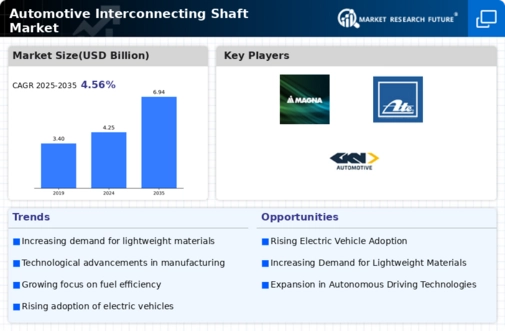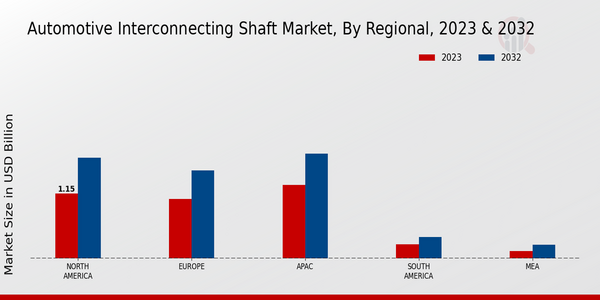Market Growth Projections
The Global Automotive Interconnecting Shaft Market Industry is projected to experience substantial growth over the coming years. The market is expected to reach 4.25 USD Billion in 2024 and is forecasted to grow to 6.94 USD Billion by 2035. This growth trajectory indicates a compound annual growth rate (CAGR) of 4.56% from 2025 to 2035, reflecting the increasing demand for interconnecting shafts in various automotive applications. The market dynamics are influenced by factors such as technological advancements, rising vehicle production, and the growing adoption of electric vehicles.
Rising Adoption of Electric Vehicles
The rising adoption of electric vehicles (EVs) is significantly influencing the Global Automotive Interconnecting Shaft Market Industry. As manufacturers shift their focus towards EV production, the design and functionality of interconnecting shafts are evolving to accommodate new powertrains and drivetrains. This transition presents opportunities for innovation in shaft design, enhancing performance and efficiency. With the global push for sustainable transportation solutions, the market is likely to witness substantial growth, driven by the increasing integration of advanced technologies in electric vehicles.
Focus on Enhanced Vehicle Performance
The Global Automotive Interconnecting Shaft Market Industry is witnessing a heightened focus on enhanced vehicle performance. Consumers are increasingly demanding vehicles that offer superior handling, stability, and overall driving experience. Interconnecting shafts play a pivotal role in achieving these performance metrics, as they are integral to the vehicle's drivetrain system. Manufacturers are investing in research and development to create shafts that can withstand higher torque and provide better responsiveness. This trend is expected to drive market growth, as automotive companies strive to meet consumer expectations for high-performance vehicles.
Increasing Vehicle Production and Sales
The Global Automotive Interconnecting Shaft Market Industry is closely linked to the overall growth in vehicle production and sales. As global economies recover and consumer confidence rises, the demand for new vehicles is expected to increase. This surge in vehicle production directly correlates with the need for interconnecting shafts, which are essential components in various automotive applications. The market is anticipated to grow at a CAGR of 4.56% from 2025 to 2035, reflecting the ongoing expansion of the automotive sector and the subsequent demand for high-quality interconnecting shafts.
Growing Demand for Lightweight Materials
The Global Automotive Interconnecting Shaft Market Industry is experiencing a notable shift towards lightweight materials, driven by the automotive sector's increasing focus on fuel efficiency and emissions reduction. Manufacturers are increasingly adopting materials such as aluminum and composite materials to produce interconnecting shafts, which can significantly reduce vehicle weight. This trend aligns with global regulations aimed at lowering carbon footprints. As a result, the market is projected to reach 4.25 USD Billion in 2024, indicating a robust demand for innovative solutions that enhance vehicle performance while adhering to environmental standards.
Technological Advancements in Manufacturing Processes
Technological advancements in manufacturing processes are playing a crucial role in the Global Automotive Interconnecting Shaft Market Industry. Innovations such as computer numerical control (CNC) machining and additive manufacturing are enabling manufacturers to produce shafts with higher precision and efficiency. These technologies not only enhance product quality but also reduce production costs, making it feasible for companies to meet the growing demand for customized solutions. As the industry evolves, these advancements are likely to contribute to the market's growth, with projections indicating a rise to 6.94 USD Billion by 2035.














